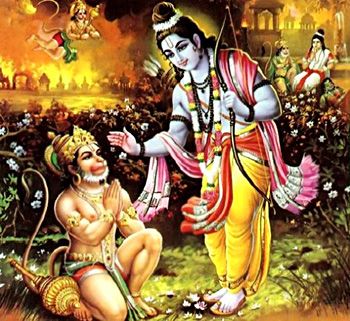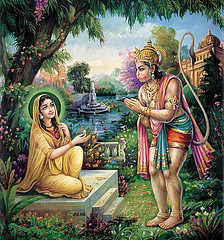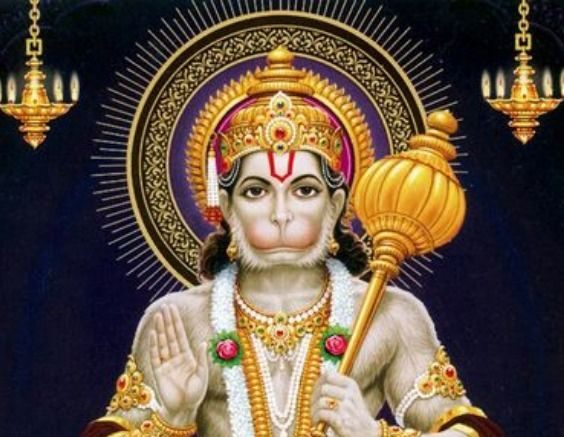No products in the cart.
सुन्दरे सुन्दरो रामः सुन्दरे सुन्दरी कथा
सुन्दरे सुन्दरी सीता सुन्दरे सुन्दरं वनम्।
सुन्दरे सुन्दरं काव्यं सुन्दरे सुन्दरः कपिः
सुन्दरे सुन्दरं मन्त्रं सुन्दरे किं न सुन्दरम्॥

Sundare sundaro ramah sundare sundari katha
Sundare sundari sita sundare sundaram vanam,
Sundare sundaram kavyam sundare sundaro kapih
Sundare sundaram mantram sundare kim na Sundara
Sundara meaning beauty and Kanda meaning section. Being the fifth Kanda our of the seven Kandas (section) of the Ramayana, Sundara Kanda can be best summarized by the above verse. The whole of Sundarakanda can be beautifully described through this verse.
Sundare sundaro Ramah
Sri Rama is beautiful. His beauty can be defined by as “Pumsaam Mohana Roopaya Punya Slokaya Mangalam” that even the men who saw Sri Ram fell in love with Ram. In Sundara Kanda, Sri Rama is not seen until the end, but the story of Sri Ram is heard a number of times by Hanuman, Sita, Vibeeshan, and the others.
Sundare Sundari Katha
Sundara Kanda is also mentioned as the story of Sundari (Bala Tripura Sundari), who is the Maya (illusive) form of Sita. It clearly shows the Maya of the divine Mother where She is visible as supreme Goddess to Hanuma who is just above Sita on a tree in Ashoka Vanam and as a normal woman to Ravana who stands just in front of her.
Sundare Sundari Sita
Mother Sita is not just beautiful by appearance but also the most beautiful through her deeds. Despite being ill-treated by Ravana, she stood strong. Her devotion towards Rama never reduced but only increased. In Sundara Kanda, Sita prays Agni to cool the fire lit at the tail of Hanuman. She was able to control the nature of a fundamental element with her power. But she refuses to use her power for herself and wants only Rama to come and take her. Isn’t this beautiful?
Sundare sundaram vanam
The Ashoka Vanam of Lanka was first described in Sundara Kanda by Valmiki. It is illustrated so beautifully that there is no other beautiful garden in the world. The trees, streams, fountains, mountains, gardens are all beyond description. In that beautiful forest lived a beautiful woman Sita.
Sundare sundaram kavyam
This implies that the entire narration of this Kanda is so comforting and soothing. The message is conveyed smoothly to any person. Sundara Kanda is a great story and lesson for every person irrespective of their age. For one past their lifetime, Sundara Kanda is the path to reach the Supreme Lord.
Sundare sundaro kapih
This statement expresses the beauty of the Kapi (monkey). Here, he is the monkey who jumped to Lanka, found Sita, and set the whole island nation on fire. It’s not the physical form of the monkey that the verse describes. It talks about the inner mind, deeds, devotion, loyalty, and love relating to the Kapi – Hanuman. Sundara Kanda perfectly explains Hanuman’s determination to go to Lanka, his humbleness, focus, hard work, and strength – all of which portray Hanuman as the most beautiful person.
Sundare sundaram mantram
The entire Sundara Kanda includes both verses that bring us inner peace, happiness, joy as well as those verses which remove our sorrows forever. It says that listening to these mantras (sacred words or utterance) one attains pure bliss and it comforts the chanters bringing in positive energy.
Sundare kim na Sundaram
The last part of the verse depicts the beauty of the Sudara Kanda as a whole. It translates to Every aspect in the Sundara Kanda is just breath-taking and beautiful – be it Lord Rama, Mother Sita, Hanuma, their story in the Ashoka Forest, and this entire narration through pleasant mantras, everything is just delightful and appealing. Then what is not beautiful?
The Beginning
Sundara Kanda begins as Sri Rama with his army reach the southern land and meet Sampati (Jatayu’s brother). Sri Rama’s army consisted of Sugreeva, Hanuman, Jambhavan, Angad, Nala, and the others. Sampati informs them that a demon king was abducting a woman and took her to the kingdom of Lanka which is across the other side of the ocean. He further adds saying that the lady was shouting for help but Sampati lost his wings by protecting Jatayu once during childhood so he was helpless.
Seeing Hanuman stand silently at the site, Jambavan – the son of Brahma, spoke to the mighty Vayuputra and reminded him of his powers and abilities.
वीर वानर लोकस्य सर्व शास्त्रविदां वर। तूष्णीमेकान्तमाश्रित्य हनुमन् किमं न जल्पसि।।
Translating to: Oh, valiant one in the world of Vanaras, being an erudite scholar among all the scriptural scholars, Hanuman, why do not you mumble something, why do you resort to calm loneliness?
हनुमन् हरि राजस्य सुग्रीवस्य समो ह्यसि।
राम लक्ष्मणयोः चापि तेजसा च बलेन च।।
Translating to: By your brilliance and brawn, oh, Hanuman, you match up to the king of monkeys Sugreeva, or even to Rama and Lakshmana, as well.
Jambhavan then goes on to describe the boon of Vayu – the wind God to Anjana and how Hanuman was born and to help him realize his powers.
मनसाऽस्मि गतो यत्त्वाम् परिष्वज्य यशस्विनि।
वीर्यवान् बुद्धि संपन्नः पुत्रः तव भविष्यति।।
महासात्त्वो महातेज महाबल पराक्रमः।
लंघने प्लवने चैव भविष्यति मया समः।।
एवमुक्ता ततः तुष्टा जननी ते महाकपेः।
गुहायाम् त्वाम् महाबाहो प्रजज्ञे प्लवगर्षभ।।
Translating to: By my presence in your mind, you are impregnated in a supersensory manner, thereby you will beget a valiant son endowed with intellect. An admirably brave, and a bravely dazzling, and a dazzlingly forceful, and a forcefully overpowering son will be there, also thus, he will be a coequal of mine in flying off and jumping up. Oh, arcane monkey Hanuman, when Air-god said so to her, oh, ambidextrous one, your mother is gratified, and then, oh, bullish fly-jumpers, your mother very well divined you in a cave.
The great Jambavan further describes the boons received by Hanuman from different Devas (Gods) in his childhood, making him realise his powers that he has long forgotten.
प्रसादिते च पवने ब्रह्मा तुभ्यम् वरम् ददौ।
अशस्त्र वध्यताम् तात समरे सत्य विक्रम।।
वज्रस्य च निपातेन विरुजम् त्वाम् समीक्ष्य च।
सहस्र नेत्रः प्रीतात्मा ददौ ते वरमुत्तमम्।।
स्वच्छंदतश्च मरणम् तव स्यादिति वै प्रभो।
स त्वम् केसरिणः पुत्रः क्षेत्रजो भीम विक्रमः।।
मारुतस्यौरसः पुत्रस्तेजसा चापि तत् समः।
त्वम् हि वायु सुतो वत्स प्लवने चापि तत् समः।।
Translating to: Oh, a chivalric warrior at war, while the Air-god is being supplicated, oh, dear boy, Brahma gave you a boon decreeing your indestructibility by any missile. On scrutinizing that you are unhurt even after hitting by Thunderbolt, oh, ablest Hanuman, the Thousand-eyed Indra kind-heartedly gave you the choicest boon saying that your death occurs only by your own volition.
Such as you are, you are Kesari’s son through his wife, oh, frightful pugilist, and you are the lineal son of Air-god, and even by your gusting you are selfsame to Air-god, and even by your flying also you are his selfsame to Air-god, in all respects.
At that moment, Hanuman having realized and having been reminded of all his abilities by the great Jambhavan then decides to cross the ocean and reach Sri Lanka. He promises his friends that he would search and find Sita in Sri Lanka.
ततः कपीनामृषभेण चोदितः
प्रतीत वेगः पवनात्मजः कपिः।
प्रहर्षयन् ताम् हरि वीर वाहिनीम्
चकार रूपम् महदात्मनस्तदा।।
Translating to: Thereafter, the best of the monkeys whose speed is familiar coupled with his irresistible enterprise being motivated by Jambhavan- the king of bears- enormously increased his physique as though to gladden the army of monkeys.
To help Hanuman in his journey, Samudradeva (the God of the sea) asked his friend the Mainaka Mountain to rise above the sea. This would help hanuman to rest for a while during his long journey. However, Hanuman refused the offer and went ahead. The Devas who witnessed this incident wanted to test the determination of Hanuman and sent Devi Surasa (Mother of Nagas – the serpents) to test him. She took the form of a Rakshasi and when encountered Hanuman, informed him that he should become her food and she will not let him go ahead. Hanuman gradually increased his size to a mega form. Surasa also made her mouth sufficiently large to swallow Hanuman. At that time Hanuman reduced his body to a thumb size jumped in and out of Surasas’s mouth to trick her. Then, Surasa blessed him and the devas were confident that Hanuman could complete the job successfully. After this, a Rakshasi (female demon) called Simhika caught hold of Hanuman’s shadow. She started dragging him into her mouth so that she could eat him. Hanuman again increased the size of his body and killed Simhika.
The Land of Lanka
Finally, Hanuman reached the city of Sri Lanka after a series of obstacles. There he took the dwarf formin the city, to avoid detection by the commoners. However, the Lanka Devatha (Goddess of Lanka) challenged him. He hit her with his clenched fist and she gave up. She then realized that the end of the city of Sri Lanka was nearing and blessed him with success. Hanuman then searched all over the city for Mother Sita. In the harem of Ravana, on seeing Mandodhari, he once thought that he had seen Sita. But he concluded that she who was living a life of luxury could not be Sita. Later he located Sita in the Ashoka forest. She was sleeping on the floor and seemed to have taken bath nor changed her dress.
While he was watching, Ravana visited Sita and requested her to be his wife. She refused and told him that the only way for him to live was to give her back to Sri Rama. Hearing this, Ravana becomes furious and says that if she had not agreed for his proposal in two months, then she will be killed. While the Rakshasis tortured Sita Devi, Trijata – the daughter of Vibhishana, told the Rakshasis about her dream in which she clearly foresaw the death of Ravana and the victory of Rama. The Rakshasis were fearful and stopped torturing Sita.
Hanuman hiding in the tree narrated the story of Rama until then. On hearing this, Sita became relieved. Then Hanuman appeared before her after the Rakshasis were asleep and narrated the adventures of Sri Rama to her. He also gave her Rama’s ring as identification. He then requested her to ride on his back and reach Rama. But Sita refused this offer, saying that this would be an insult to Rama’s valor, and also because as a virtuous woman, she would not touch another male willingly apart from her husband Lord Frama himself.

भर्तुर्भक्तिं पुरस्कृत्य रामादन्यस्य वानर। न स्पृशामि शरीरं तु पुंसो वानरपुङ्गव।।
Translating to: “O chief of Vanaras I cherish my devotion towards Rama alone and not touch the body of any other man.”
She gave him her pearl hair brooch as identification. This brooch was given to her by her father. She also told him the story of the crow that attacked her and how Rama put a Tilak on her forehead with a red stone.
Hanuman took a leave from Sita and while returning made up his mind to greet Ravana as well as the city of Lanka. To seek attention to himself, he destroyed the Ashoka forest. Hanuman killed all of the warriors Ravana sent to capture Hanuman – including his son Akshaya Kumara. Then Ravana sent his elder son Indrajit to capture Hanuman who succeeded by using his Brahma Astra (celestial weapon). Hanuman seemingly submitted himself to the rakshasas and reached the court of Ravana.
Ravana’s Court
At his behavior, Ravana awarded capital punishment to Hanuman. However, Vibhishana – the younger brother of Ravana, pointed out that such a punishment couldn’t be given to emissaries.
क्षमस्व रोषं त्यज राक्षसेन्द्र प्रसीद मद्वाक्यमिदं शृणुष्व।
वधं न कुर्वन्ति परावरज्ञा दूतस्य सन्तो वसुधाधिपेन्द्राः
Translating to: “O king of ogres give up your wrath, forgive and calm down. Please listen to my appeal. You know the basic values of life. Virtuous rulers of the earth do not order the killing of an envoy.”
Agreeing to his view, Ravana ordered the Rakshasas to set fire to the tail of Hanuman. Acceding to the prayer of Sita, who heard the news from other Rakshasis, Agni Deva (the God of fire) did not hurt Hanuman. Hanuman escaped from the clutches of the Rakshasas by his powers and using the fire in his tail, set fire to the entire city of Lanka. Then he took leave of Sita and jumped back to the other shore.
He then narrated the entire scene to his friends and they together decided to tell it to Sri Rama. On their way back to Sri Rama, they destroyed the honey garden of King Sugreeva. They then reached Kishkinda and informed the others in detail that they had been able to find Sita and that she was sad. They further add that she was guarding her virtue and that she would be executed by Ravana in 2 months.
This marks an end to Sundara Kanda. It teaches important life lessons to readers of any age group. For a growing teen, Sundara Kanda teaches the determination, discipline for life. For a young adult ready to start a family, Sundara Kanda teaches the importance of respecting women. For one in midlife, it teaches the priorities of life. This Kanda of the Ramayana captures the determination of Hanuman to succeed, in spite of the numerous hurdles that kept interrupting his journey to Lanka. Such is the determination one should cultivate in life.






